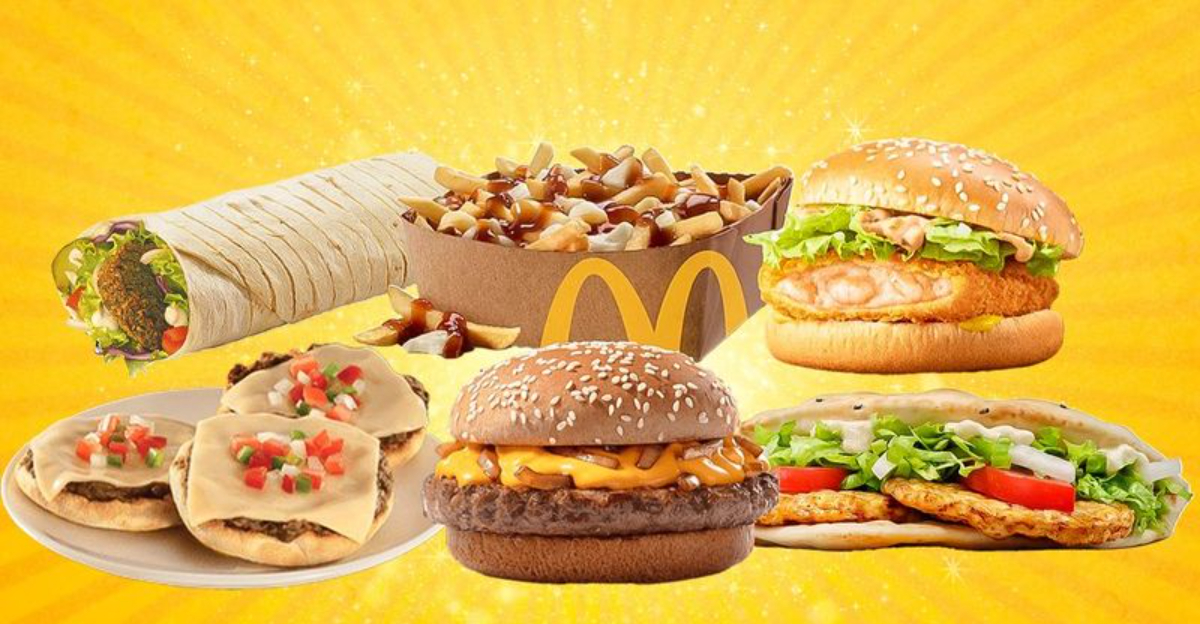14 Things You Didn’t Know About McDonald’s Menu History That Will Shock You

McDonald’s has been flipping burgers and serving up fries for decades, but there’s much more to their menu than most people realize.
Ever since my first Happy Meal as a kid, I’ve been fascinated by the golden arches and how their offerings have evolved over the years.
Behind the familiar Big Macs and McNuggets lies a history filled with surprising twists, from discontinued experiments and regional exclusives to secret ingredients and behind-the-scenes innovations. Some menu items have come and gone in a flash, while others quietly became fan favorites. Let’s take a closer look at McDonald’s lesser-known culinary journey.
1. The Original Menu Featured PB&J Sandwiches
Before McDonald’s became burger royalty, they actually served peanut butter and jelly sandwiches in 1940! I nearly dropped my fries when I discovered this childhood staple was part of their original lineup.
The McDonald brothers quickly realized hamburgers were their ticket to success, closing shop in 1948 to restructure their entire business model. When they reopened, burgers took center stage, setting the foundation for the global empire we know today.
Imagine if they’d stuck with PB&J, we might be ordering the McJelly instead of Big Macs!
2. The Big Mac Was Almost Called ‘The Aristocrat’
Fancy ordering an Aristocrat with fries? That’s what you’d be saying if McDonald’s had stuck with their original name for the Big Mac. My jaw hit the floor when I learned this iconic sandwich initially sported such a highbrow title!
Created in 1967, the sandwich cycled through names like ‘The Aristocrat’ and ‘The Blue Ribbon Burger’ before marketing wizards settled on ‘Big Mac.’ The name change proved genius, can you imagine trying to mumble ‘Aristocrat’ through a mouthful of special sauce?
Sometimes simplicity wins the fast food game.
3. The Filet-O-Fish Was Born From Religious Observance
My Catholic grandmother always ordered Filet-O-Fish on Fridays, but I never knew why until recently. This sandwich wasn’t just a random menu addition, it was specifically created to solve a religious dilemma!
In 1962, Cincinnati McDonald’s owner Lou Groen noticed his Friday sales tanking because local Catholics abstained from meat during Lent. His solution? A breaded fish sandwich that would keep observant customers coming through his doors even on meatless days.
Ray Kroc initially resisted but eventually caved when the fish sandwich outsold his own meatless creation in a head-to-head test.
4. The Failed Pineapple Burger Experiment
Pineapple on pizza sparks heated debates, but pineapple on burgers? McDonald’s actually tried it! The bizarre ‘Hula Burger’ featured a grilled pineapple slice with cheese on a bun, no meat whatsoever.
Ray Kroc himself championed this tropical oddity in 1962 as another meatless option for Lent observers. I tried recreating it at home once (curiosity got the better of me) and let’s just say some culinary experiments deserve to stay in the past.
The Hula Burger flopped spectacularly against the Filet-O-Fish in taste tests, quickly becoming a forgotten footnote in fast food history.
5. McDonald’s Coca-Cola Tastes Different For A Reason
Ever wondered why McDonald’s Coke tastes extra refreshing? I thought it was just my imagination until learning their secret! Unlike other restaurants, Mickey D’s receives its Coca-Cola syrup in special stainless steel tanks rather than plastic bags.
This unique delivery method preserves the syrup’s flavor profile better than standard packaging. They also filter their water meticulously, pre-chill the syrup before it enters the fountain machine, and use slightly wider straws to maximize that sweet fizzy goodness.
Next time you sip that perfect McDonald’s Coke, you’re experiencing the result of a carefully engineered taste system!
6. The World’s Largest Toy Distributor Isn’t A Toy Store
Hold onto your Happy Meal toys, McDonald’s distributes a mind-boggling 1.5 billion toys annually! When my nephew learned this fact, he calculated he’d need to eat Happy Meals for 4.1 million years to collect them all.
This massive toy operation makes the golden arches the planet’s largest toy distributor, outpacing even dedicated toy retailers like Toys ‘R’ Us. The Happy Meal, introduced in 1979, transformed McDonald’s from just a restaurant into a cultural phenomenon for kids.
Many of these tiny treasures have become valuable collectibles, with rare Happy Meal toys fetching hundreds of dollars from nostalgic adults trying to recapture childhood memories.
7. The McDLT’s Environmental Packaging Disaster
Remember the McDLT? This 1980s sandwich came in a bizarre Styrofoam contraption that kept the hot side hot and the cool side cool, literally dividing the burger into two compartments! As a kid, I thought it was the coolest thing ever.
The packaging featured a hot chamber for the meat and bottom bun, while lettuce, tomato, and top bun chilled in the separate cool section. Customers assembled the burger themselves, experiencing that satisfying temperature contrast with every bite.
Environmental concerns about the excessive Styrofoam eventually doomed this innovative sandwich, teaching McDonald’s a valuable lesson about balancing novelty with sustainability.
8. Global Menu Items You’ll Never See In America
During my backpacking trip through Asia, I stumbled upon a McDonald’s selling Samurai Pork Burgers in Thailand, nothing like this exists back home! McDonald’s international menu adaptations showcase fascinating cultural fusion.
In India, the Maharaja Mac replaces beef with chicken to respect Hindu dietary customs. Israeli locations serve McFalafel, while Japanese McDonald’s offers Teriyaki Burgers and Shrimp Filet sandwiches. Australian menus feature McCafés with proper barista-made coffee long before the concept reached American shores.
These regional specialties reflect McDonald’s surprisingly flexible approach to menu development, proving the chain isn’t as standardized as most people assume.
9. The McRib Originated From A Chicken Shortage
The cult-favorite McRib wasn’t created because McDonald’s executives loved barbecue, it was actually born from desperation! Back in 1981, chicken farmers couldn’t keep up with the explosive demand for the newly introduced Chicken McNuggets.
Facing a potential menu crisis, McDonald’s executive chef Rene Arend quickly developed the pork-based McRib as a strategic diversion. I remember my father driving to three different McDonald’s locations during the sandwich’s limited run in 1989, determined to taste this elusive creation.
The sandwich’s now-famous limited availability wasn’t initially planned, it became a marketing tactic only after inconsistent sales made it impractical as a permanent offering.
10. The McRib Contains Zero Actual Ribs
The McRib’s secret shocked me more than finding an extra chicken nugget in my 6-piece box! Despite its bone-shaped appearance, this sandwich contains absolutely no rib meat whatsoever.
The patty is actually constructed from restructured pork shoulder, ground and formed into that distinctive rib-like shape. Food scientists use a complex binding system of salt and water to extract proteins from the pork, creating a meat glue that holds everything together in that familiar form.
The sandwich’s 70+ ingredients include azodicarbonamide, a flour-bleaching agent also found in yoga mats and gym shoes! Don’t worry though, it’s perfectly FDA-approved for consumption.
11. The Arch Deluxe: McDonald’s $300 Million Adult Burger Flop
My first restaurant job interview happened the same week McDonald’s launched the Arch Deluxe in 1996. Little did I know I was witnessing one of the most expensive fast food failures in history!
McDonald’s spent a staggering $300 million developing and marketing this ‘sophisticated’ burger targeted specifically at adults. The campaign bizarrely featured children expressing disgust at the burger’s ‘grown-up taste’, hardly appetizing imagery for any demographic.
Despite its fancy circular bacon, peppered bacon, and special mustard-mayonnaise sauce, customers just weren’t willing to pay premium prices at a restaurant known for value meals. The Arch Deluxe vanished within a year.
12. McLobster: The Luxury Sandwich That Mostly Failed
Imagine my surprise finding a lobster roll at McDonald’s during a New England road trip! The McLobster, a genuine lobster sandwich, remains one of McDonald’s most puzzling menu experiments.
First appearing in 1993, this unlikely creation features actual Atlantic lobster meat mixed with McLobster sauce (similar to lobster roll dressing) on a special roll. While it gained traction in Maine and Canadian Maritime provinces where lobster is plentiful and affordable, attempts to introduce it elsewhere met swift rejection due to high prices and skepticism about seafood quality.
The sandwich still makes seasonal appearances in select coastal locations, proving McDonald’s occasionally ventures far beyond its comfort zone.
13. The Mythical McGratin Croquette From Japan
During my teaching stint in Tokyo, I discovered the strangest McDonald’s item I’ve ever encountered, the McGratin Croquette! This Japan-exclusive creation looks like someone deep-fried a bowl of creamy soup.
The sandwich features a deep-fried patty filled with macaroni, shrimp, and mashed potatoes, topped with a special demi-glace sauce. Japanese McDonald’s introduced it in 1993 as part of their strategy to incorporate familiar local flavors into their menu, as croquettes are a beloved snack throughout Japan.
The McGratin exemplifies how dramatically McDonald’s adapts to local tastes, creating items that would be completely unrecognizable to American customers.
14. The Secret Ingredients In McDonald’s Fries Changed Forever
My grandfather always claimed McDonald’s fries tasted better in the old days, turns out he wasn’t imagining things! Until 1990, McDonald’s cooked their world-famous fries in a beef tallow mixture that gave them a distinctive savory flavor impossible to replicate with today’s vegetable oil.
The switch came after health activists pressured the chain to abandon animal fat. McDonald’s now uses a blend of vegetable oils enhanced with natural beef flavor to approximate the original taste.
Early McDonald’s potatoes were also sourced exclusively from Idaho Russet Burbanks, chosen specifically by Ray Kroc for their perfect length and starch content, details that contributed to their legendary status.
